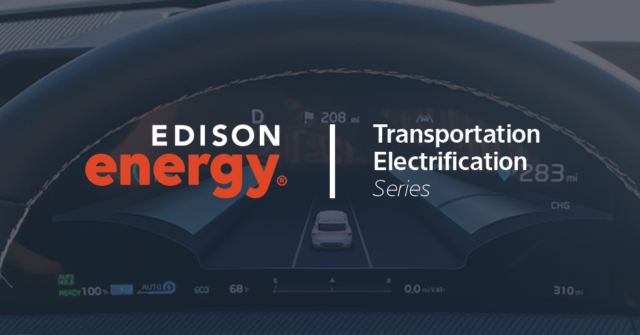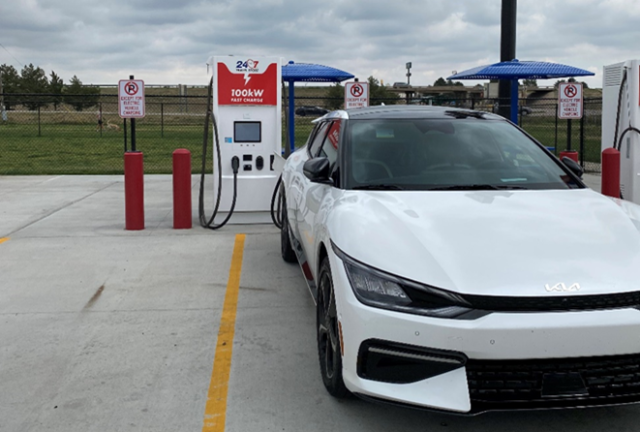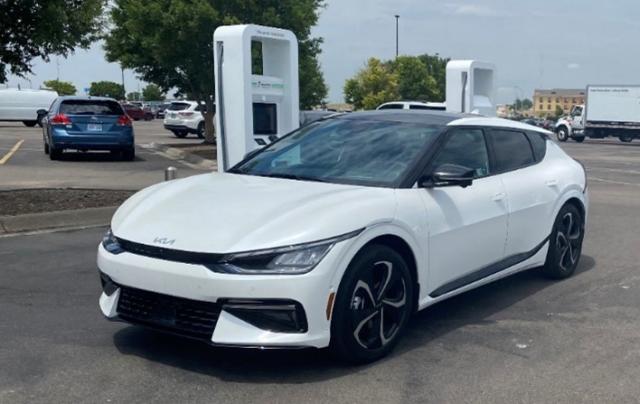
September 28, 2022
My 1,200-mile EV Road Trip: From Colorado to Kansas on Fully Electric
By Ali Walling, Manager, Transportation Electrification

Ever wondered what it would be like to take an eight-hour+ road trip in a fully electric vehicle (EV)? Is it possible in a vehicle that’s not a Tesla? Let’s find out!
Choosing our Electric Vehicle
My husband, Ryan, and I recently bought our first EV – a 2022 Kia EV6. We are both in the EV industry, helping clients navigate vehicle and charging selections, so it was finally time to put that knowledge to work and choose an EV to call our own.
We specifically went with the Kia EV6, largely because it is built on 800-volt architecture, meaning it can charge quickly – like 20-minutes-on-a fast-charger quickly. It has 275 miles of range and all-wheel drive, which was a requirement for our many trips into the mountains to explore the beauty of Colorado and beyond.
To say we were excited about this purchase was an understatement – it was all we could talk about from the moment we found out our vehicle was in production until the time we signed the paperwork. Even more exhilaration was in the offing when we found out that our beautiful snow-white Kia – which we named Jon Snow after the famous Game of Thrones character – would be ours just in time to take on a road trip the following week.
Driving a long distance in a fully electric vehicle that would require multiple charging stops might not be something first-time EV drivers would tackle. But with our career expertise and countless hours of research, it was time to finally walk the walk. Or, in this case, drive the EV. We were ready, fearless. After all, isn’t diving in headfirst the best way to learn something new? Isn’t the saying ‘go big or go home’?
Hitting the Open Road
After an entire week of being official EV owners, Ryan and I, along with our two dogs Sasha and Sofie, packed up Jon Snow to make the nearly 600-mile road trip from Denver, Colorado to Lawrence, Kansas.
We carefully planned out our very “complicated” route (hop onto I-70 for about 500 miles) and charging stops ahead of time, using the PlugShare app to locate our “fueling” stops. The night before, we made sure to fully charge with our home Level 2 charger, and we were on the road early the next morning.
| Utility EV Charging Program: Through our local utility provider, we were able to choose between two different Level 2 chargers for a monthly payment of $13 and a $500 rebate on installation. Through this program, we are required to charge from 9 pm – 6 am 25% of the time and receive a $5 credit on our electric bill annually. |

Our first leg of the trip started out with 283 miles of range, two sleepy dogs, and the open road ahead. This was the most exciting part of the trip-we could still see the Rocky Mountains behind us, along with the hustle and bustle of the Denver metro area. We felt the cool, crisp, 68-degree mountain air through the open windows–the coolest temperatures we would see for the next five days by about 20 degrees.

After three hours on the road, we pulled up to the first station to charge – with 27 miles to spare. With so much new technology in the car, we were still learning how to use things like the heads-up display, automatic lane change, and lane-keeping assist, as well as how far we could push the mileage before a charge.

As this was our first road trip in our new car, we were starting to feel what most first-time EV users experience–range anxiety. We had meticulously planned our trip and knew we had enough charge, yet there was still a fear that we’d run out before we made it to our first charging destination.
The first stop was at a 24/7 gas station just off I-70. This was by far the best charging stop of the entire trip, maybe because it felt the most like a traditional stop given that it was a gas station that offered EV charging. The chargers were right next to a dog park with lots of green space, and there were two picnic tables with umbrellas for us to sit down and eat some breakfast. There was even a designated windshield cleaner right next to the charging stations.
We pulled in next to a Mitsubishi plug-in hybrid and began charging. Of course, with these amenities came a premium – the stop turned out to be the most expensive of the trip. We spent $31.58 charging up at the EV Connect 50 kW charger, using 53.52 kWh and charging up to 80% in 34 minutes.
| Wondering why we only charged to 80%? Well, the short answer is that this helps to maintain the life of the battery. When charging with a DCFC (or direct current fast charger), the vehicle doesn’t have to convert energy from alternating current (AC) to direct current (DC) since it’s already being delivered that way. This means that it can charge much faster than level 1 or level 2 (for a charging overview, click here!) Because of this high influx of energy, vehicle and charging manufacturers have designed their products to cut off at 80% to help maintain the life of the battery. In addition, charging from 80% to 100% takes about the same amount of time as it does from 20% to 80% because the ions in the battery need to stabilize. It’s kind of like a spring–easy to compress at first. However, the longer you try to compress, the more resistance you hit. |

With Jon Snow almost fully charged, the dogs rejuvenated, and Ryan and I feeling refreshed, we were ready to hit the road. We now had 203 miles of range and it was 142 miles until our next charging stop, with another 230 miles on I-70 to go until we made it to Lawrence, Kansas.
When we purchased the car, one of the perks was the Kia Charge Pass, which allows for 1,000 kWh of free charging on the Electrify America network, so we were excited when we finally made it to one of those chargers at Stop #2 in Hays, Kansas. This was far less glamorous than the first stop. The charger was located in a Walmart parking lot, and we had to carry our dogs over the hot asphalt to find some shade to escape the blistering temperatures.
We also had our first minor charging setback–halfway through, it stopped charging and we had to restart the entire process. While this was not a major issue, for those who might not be totally sold on EVs, it could give the charging experience a bad rep. Thankfully, the charging went quickly and at no cost to us, and we were back on the road in no time. We made two more stops – both on the Electrify America network – which has charging locations every 100 miles.
We spent three lovely but very hot days visiting family in Lawrence, exploring downtown, and even enjoying a day at the lake to beat the 100-degree days. While the Airbnb we stayed at did not offer EV charging, we were able to find fast charging stations at a local shopping mall, as well as other locations in the area.

Breaking it Down
Below is a breakdown of all the charging we did on our trip. At nearly all of these charging stops we were not the only vehicle utilizing public charging. We were excited and a bit surprised to see so many EVs on the road. Note that Electrify America charging was free due to our Kia Charge Pass but is listed as what it would have cost without a pass.
 * We did not need any charging on Day 3.
* We did not need any charging on Day 3.
Looking Ahead/Key Takeaways
Overall, the EV road trip was amazing and 10/10 we will do it again, largely because we know that driving an EV is better for the environment. We took our brand new fully electric car on this road trip because we truly believe in the technology as the path forward for electrification and greenhouse gas reductions. By taking our EV vs. our gasoline-fueled 2013 Toyota Rav 4, we emitted no tailpipe emissions during the 1,300 miles we drove, while the Rav 4 would have emitted 996 lbs. of CO2 over the same period.
That said, there are a few things that could have made our trip even better. These include upgraded amenities at fast-charging locations like pet-friendly areas, shaded picnic tables, designated bathrooms, and some local food options. For me, the most challenging part of charging was the lack of nearby restrooms, food, and windshield cleaners. However, being an early adopter of this incredible technology means working through some of the hiccups as we build out the charging infrastructure.
As the infrastructure grows and more electric vehicles take to the roads, I have no doubt that the charging experience will exponentially improve. I foresee the phasing out of today’s subpar charging station locations and the ushering in of new, deluxe charging stops with the very best amenities.
For more information, check out our Transportation Electrification Blog Series.
Join Our Mailing List
Let us meet you where you are in your Transportation Electrification journey.
Get connected with our team.
Learn More



